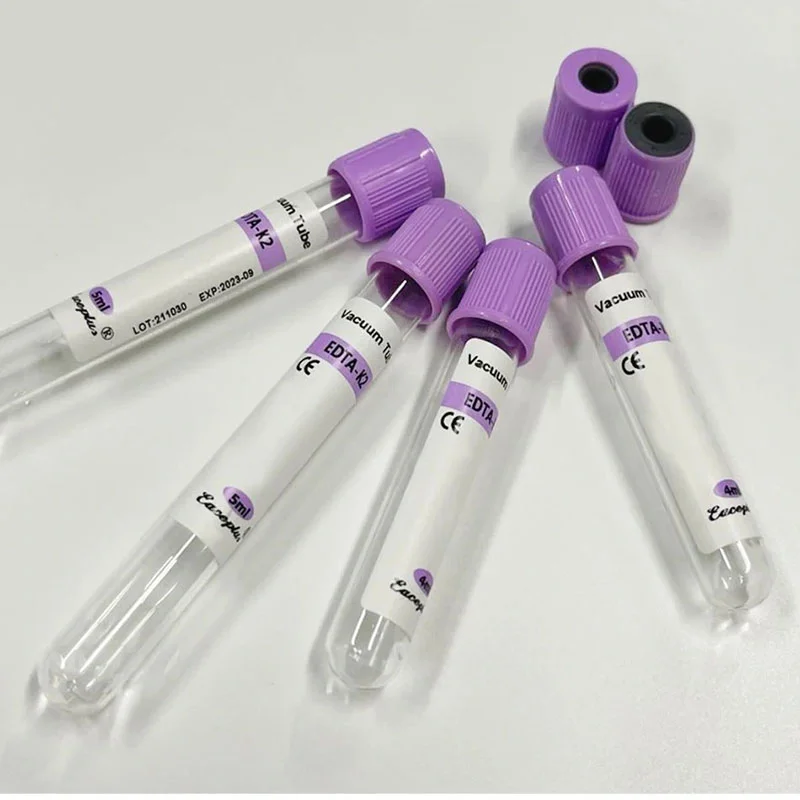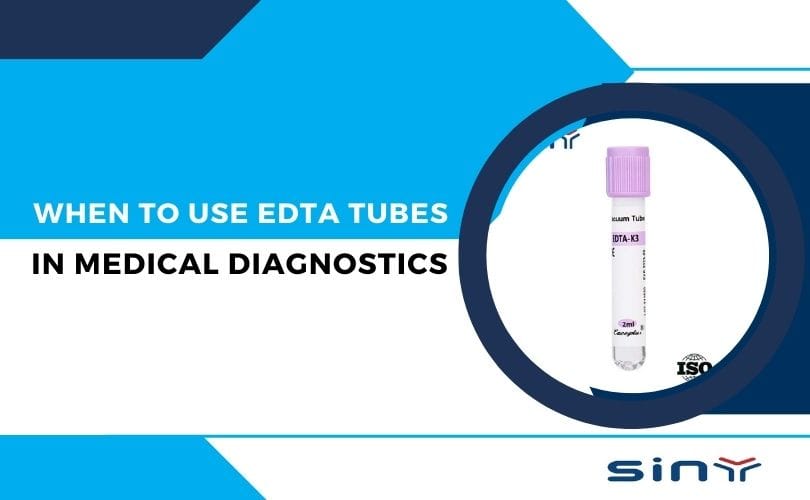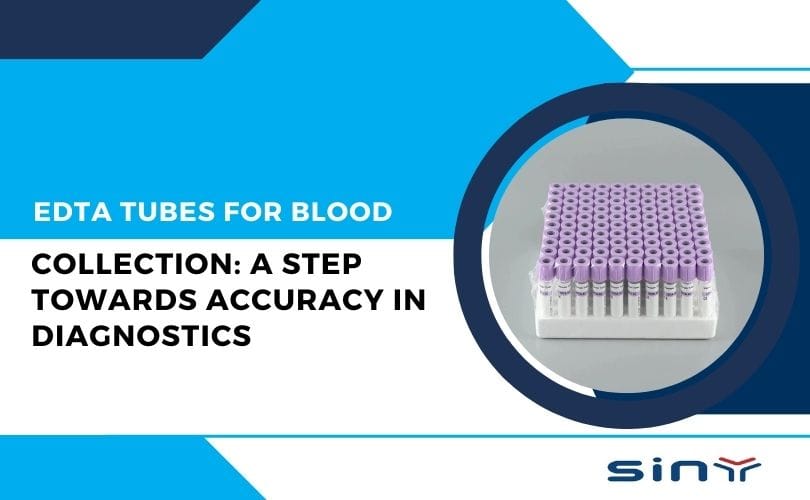Blood collection tubes are fundamental tools in medical diagnostics, and two commonly used types are EDTA Tubes and Heparin Tubes. While both play an essential role in blood tests, they differ in their applications, uses, and how they interact with blood samples.
Understanding the distinct characteristics of these two tubes can ensure the proper selection for accurate test results. In this detailed guide, we will explore how EDTA Tubes compare to Heparin Tubes, their specific uses, and when each should be utilized.
What Are EDTA Tubes?
EDTA tubes are one of the most widely used blood collection tubes in medical laboratories. EDTA stands for Ethylenediaminetetraacetic acid, a chelating agent that binds calcium and other metal ions in the blood. The function of EDTA is critical in preserving blood samples for hematology tests by preventing blood clotting.

EDTA Tubes come with a lavender-colored cap and are often used for tests that require whole blood or plasma. This includes routine blood count tests, blood smears, and other hematological examinations. The unique property of EDTA is its ability to keep blood from clotting by binding calcium, which is essential for the clotting cascade.
For a comprehensive look at EDTA tubes, check out EDTA Tubes for Blood Collection.
What Are Heparin Tubes?
Heparin tubes are another type of blood collection tube, containing heparin, a naturally occurring anticoagulant. Unlike EDTA, which binds calcium, heparin works by inhibiting thrombin and other clotting factors, preventing blood clot formation. This makes Heparin tubes ideal for plasma tests where blood clotting needs to be avoided, especially in biochemical and clinical chemistry tests.
Heparin tubes typically have a green-colored cap, and they come in two main varieties: Lithium Heparin and Sodium Heparin. Both are used for plasma collection but are suitable for different types of tests. Lithium Heparin is generally preferred for testing electrolytes, glucose levels, and for certain enzyme assays.
To learn more about Heparin tubes, explore the Heparin Tube collection here.
EDTA Tubes vs. Heparin Tubes: Key Differences
The primary difference between EDTA Tubes and Heparin Tubes lies in the anticoagulant used and the type of test they are suited for.
1. Anticoagulant Mechanism
- EDTA Tubes use Ethylenediaminetetraacetic acid to bind calcium in the blood. This stops the clotting process by preventing the calcium from participating in the clotting cascade.
- Heparin Tubes contain heparin, which inhibits thrombin and other clotting factors, stopping clot formation by a different mechanism.
2. Blood Sample Type
- EDTA Tubes are typically used for whole blood or plasma. The samples remain in a liquid state after collection, making them ideal for hematological tests like Complete Blood Count (CBC) or blood smears.
- Heparin Tubes, on the other hand, are used for plasma and are most suitable for biochemistry tests, including electrolyte analysis, glucose testing, and liver function tests.
3. Application in Laboratory Tests
- EDTA Tubes are the go-to choice for tests that require whole blood, like hematology panels. EDTA preserves the cellular components of blood, which is crucial for tests such as hemoglobin levels and red blood cell counts.
- Heparin Tubes are preferred for tests that require plasma rather than whole blood. These include serum chemistries, cardiac markers, and other biochemical tests that focus on plasma rather than blood cells.
When to Use EDTA Tubes
EDTA tubes are primarily used for hematology tests and situations where blood cells need to be preserved. Some of the most common applications of EDTA tubes include:
- Complete Blood Count (CBC): Measures levels of various blood components, including red blood cells, white blood cells, and platelets.
- Blood Smear Preparation: Used in microscopic analysis of blood cells.
- Hemoglobin and Hematocrit Testing: Helps in diagnosing anemia and other blood-related conditions.
- Blood Typing: EDTA is used in blood typing to prevent clotting.
For a detailed product description of EDTA Tubes and their usage, you can explore the EDTA Tubes Product Page.
When to Use Heparin Tubes
Heparin tubes are mainly used for tests that require plasma rather than whole blood. Heparin works to prevent clotting without affecting the plasma’s integrity, making it ideal for certain biochemical tests. Here are the key situations when Heparin tubes should be used:
- Electrolyte Analysis: Heparin tubes help maintain the integrity of plasma for tests involving potassium, sodium, and chloride levels.
- Liver Function Tests: For analyzing enzymes such as AST, ALT, and alkaline phosphatase in plasma.
- Glucose Testing: Heparin tubes are used for accurate glucose testing as they prevent blood clotting that could alter glucose concentration.
- Hormone Testing: Many hormone panels are conducted on plasma samples collected in Heparin tubes.
For further insights, visit Heparin Tubes Information.
Advantages of EDTA Tubes
- Prevents Clotting: EDTA effectively prevents clotting by binding calcium, making it essential for hematological tests.
- Stable Blood Cell Preservation: EDTA tubes preserve the shape and integrity of blood cells, which is critical for accurate cell analysis.
- Widely Used in Clinical Laboratories: These tubes are a standard in hospitals and labs for hematology, ensuring compatibility with most diagnostic tests.
For a look at our EDTA Tubes for blood collection, explore EDTA Tubes on our website.
Advantages of Heparin Tubes
- Quick Plasma Preparation: Heparin tubes help in rapid plasma separation, which is ideal for quick biochemical analysis.
- Minimal Interference: Heparin does not interfere with most biochemical assays, making it suitable for a wide range of tests.
- Versatile for Plasma-Based Tests: These tubes are great for tests involving plasma, offering flexibility in clinical chemistry applications.
For more on Heparin Tubes, visit Sinymedical Heparin Tubes.
In conclusion, EDTA tubes and Heparin tubes each have their unique advantages and are suited for different types of blood tests. EDTA tubes are ideal for hematological tests where blood cells must be preserved, while Heparin tubes are used primarily for plasma-based tests in clinical chemistry and biochemistry. Understanding the specific role of each tube can help ensure accurate results in diagnostic labs.
For more information about EDTA Tubes and other laboratory supplies, explore our full product selection here.
FAQs on EDTA and Heparin Tubes
Q1: Can I use an EDTA tube for glucose testing?
No, EDTA tubes are generally not recommended for glucose testing as they can interfere with glucose levels. Heparin tubes are preferred for accurate glucose testing.
Q2: Why are EDTA tubes purple?
The purple (lavender) cap color is a standard identifier for EDTA tubes in blood collection systems, helping lab technicians quickly recognize the tube type.
Q3: Can I use Heparin tubes for Complete Blood Count (CBC)?
No, Heparin tubes are not ideal for CBC tests. EDTA tubes are preferred because they preserve blood cells, which are required for this test.
Q4: How long can I store blood in EDTA or Heparin tubes?
Both EDTA and Heparin tubes can store blood samples for several hours to a day, depending on the test. However, for the most accurate results, testing should be performed as soon as possible.






